In the modern game, the ability of a player to pass and progress the ball is becoming more and more important as the seasons go on. Players today are far more defensively aware than they once were and with the increase in physical capacity across the board at the top level, we now see players in the possession phase coming under more and more pressure. Even central defenders and fullbacks have less time on the ball now than they used to, even a few years ago. This means that players in all positions have to be comfortable receiving and playing the ball either around or through the defensive block of the opposition.
This means that players who have the ability to play passes that break the line of the opposition and progress the ball up the field are becoming inherently more valuable as the years go on. These passes can be line breaking, in that they play through into the middle third of the pitch, or diagonal/direct, in that they switch the play and move either closer or to the final third of the pitch.
Using statistics to identify progressive passers is relatively simple, right? Download the data from your data provider of choice, connect that data to your code or to a platform like Tableau and you can start to build visualisations that show the most progressive passers in your data set or those that play the most passes into the final third if you prefer. The issue that can arise here is that the data in your dataset will be skewed towards the teams who are most successful in possession dominance.
Let’s take that point though and break it down a little. If player A plays for a possession-dominant team who are challenging for Europe, and player B is playing for a more defensive side who are fighting against relegation then it is likely (not certain, but likely) that player A will attempt more passes per 90 than player B. Let’s say player A attempts 60 passes per 90 while player B attempts 28 passes per 90. It is clear that player A will have far more opportunties to play that progressive pass that we like.
In order to get around the performance bias that is in our data set we can use a relatively simple trick that allows you to gauge the potential effectiveness of players at teams who finished towards the bottom of the table or were even in teams who were relegated. I like to use a model that shows me which percentage of a teams total progressive passes over the course of the season each player is responsible for. So, with Player A, who averages a high volume of passes, we can realistically assume that his team as a whole averaged a higher volume of progressive passes than the team that player B plays for. This changed the picture within the dataset and starts to bring players to the fore that we can assume would benefit from a move to a team who perhaps better fit their skill set in their position.
In this data analysis, we will use this technique to show three players, in three different positions, that we believe are undervalued and that are good ball progressors. In this analysis, the data set that we are using has players from the top-5 European leagues. We have filtered this to show fullbacks, central defenders and central midfielders and we are looking for players who are 23 years old or under and that played at least 1200 minutes over the course of last season. Our data is all from Wyscout and the visualisations are created using Tableau and Python.
We will identify one fullback, one central defender and one central midfielder.
The Fullback
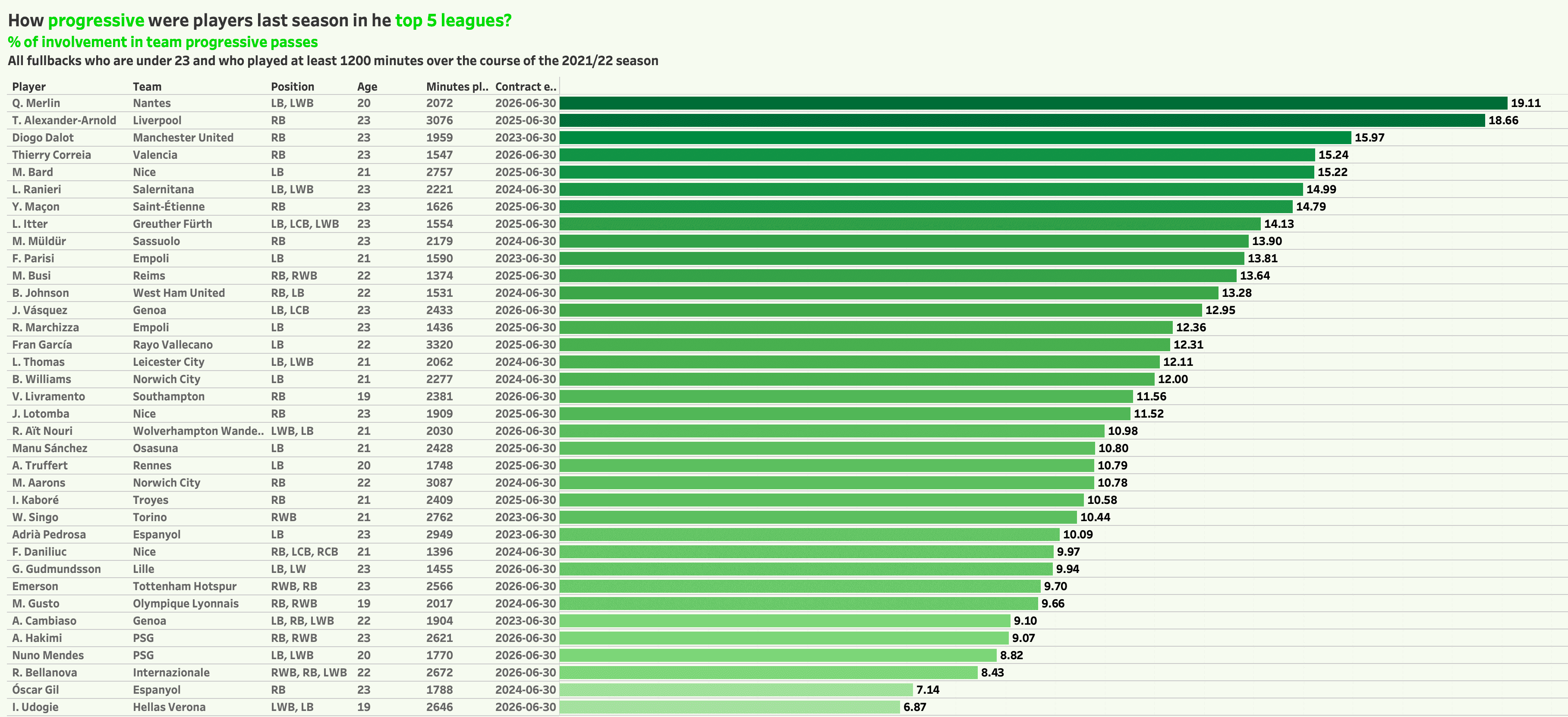
First things first, we will be discounting the presence of Liverpool fullback Trent Alexander-Arnold from our analysis because, as impressive as his performances were last season, he is anything but undervalued. Now, we are left with a group of very interesting young fullbacks.
I have previously written on this side about Fabiano Parisi of Empoli, Issa Kabore of Troyes, Maxime Busi or Reims and Melvin Bard of Nice but this time it is a relative newcomer who has caught the eye. Well, I say caught the eye but it is difficult to ignore the player at the top of the whole ranking, above even Alexander-Arnold, in Quentin Merlin of Nantes in Ligue 1.
Let’s pause for a moment though to reinforce the need for looking at the data in this manner. Over the course of last season Nantes averaged 60.43 progressive passes per 90 compared to Liverpool’s 83.43 progressive passes per 90. Merlin was responsible for 19.11% of Nantes’ total progressive passes while TAA was responsible for 18.66% of Liverpool’s progressive passes. Now, the point should stand that a player like Merlin moving to a more possession based team would seen a marked increase in output.
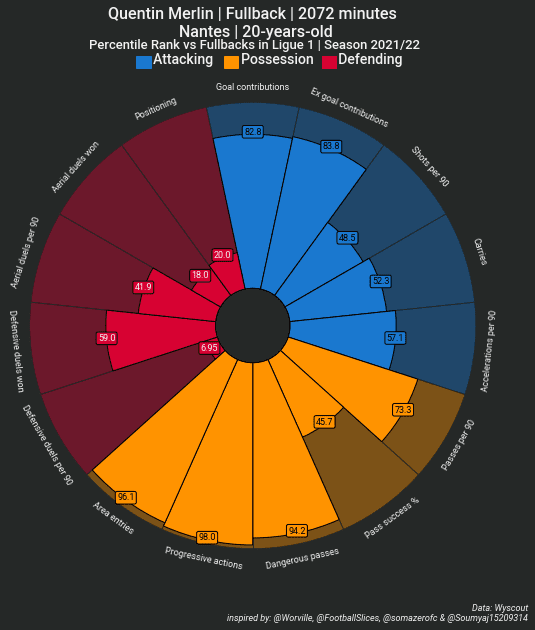
Let’s take a closer look at Merlin’s performances across the course of the season as Nantes finished in ninth place.
As you can see, he profiles very much as a fullback or wingback who is at his best in the possession phase of the game and his passing and progression metrics stand out. He is in the 73rd percentile for passes per 90 amongst fullbacks in Ligue 1 so he does have some volume there. More importantly though, at least for the basis of this article, he uses the ball extremely well. He is in the 98th percentile for progressive actions, the 94th percentile for dangerous passes and the 96th percentile for area entries. All of these show that Merlin is extremely capable of contributing to his side in the attacking phase of the game.
So far this summer, we have seen Aston Villa, a side who are very smart in the market, heavily linked to a move for Merlin. Given his performances last season, it should not be a surprise to see him move.
The Central Defender
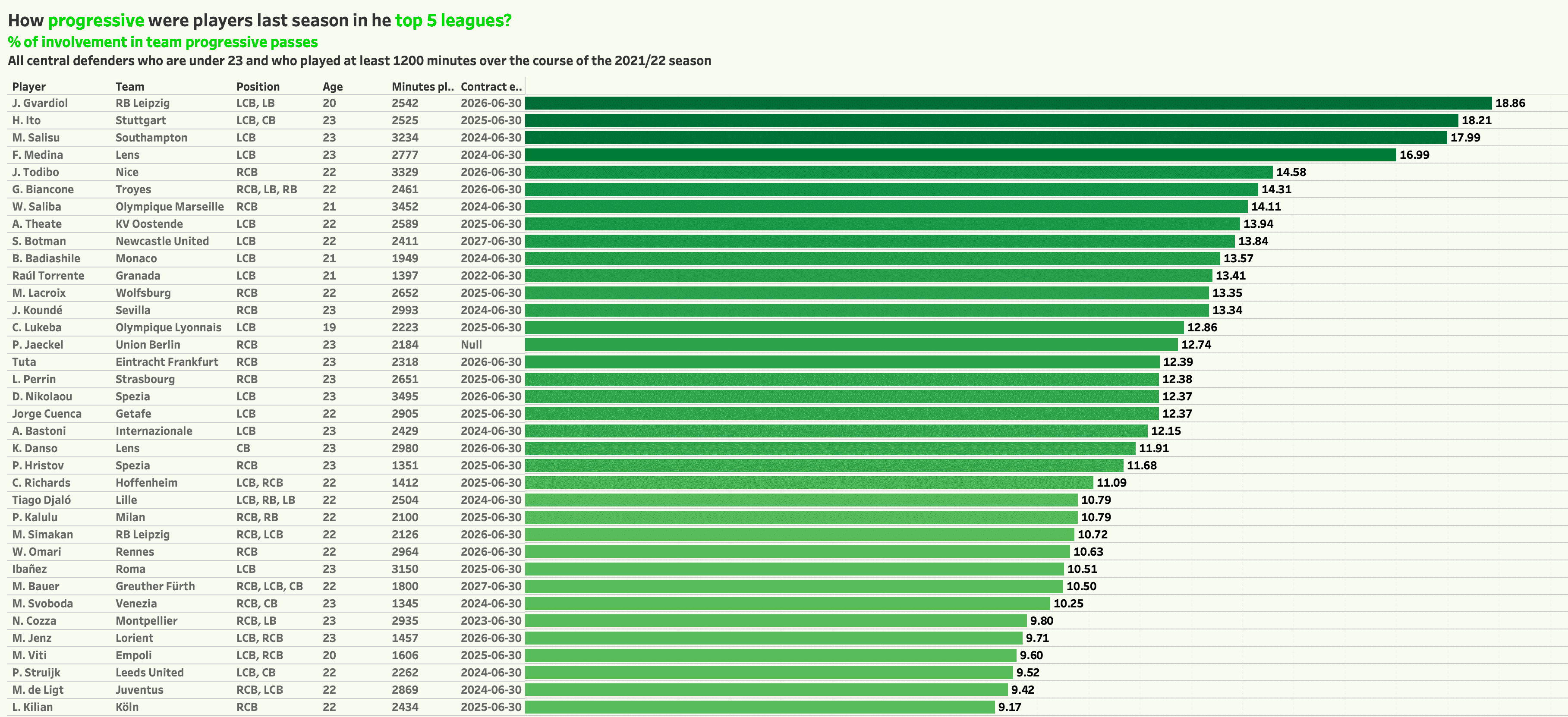
Now, let’s move on to central defenders. The first thing to note here is that Josko Gvardiol of RB Leipzig is very, very, very good, as with TAA in the last section. However, I would struggle to realistically claim that he is underrated. At a quick glance down the ranking I can see 14(!) players that I have written about on this site at one point or another. I should probably pause then to acknowledge that I do indeed have a preference when scouting central defenders towards those who are comfortable with the ball at their feet.
This time though, I will stretch the definition of underrated to choose Mohammed Salisu of Southampton as my player of choice. I firmly believe that Salisu, who had an excellent season last term, is destined to play for a team who are regulars in the Champions League. Earlier this year, Saints rejected a bid from Newcastle that was reported to be in the £40M range for the young central defender. He is destined to move for much more.
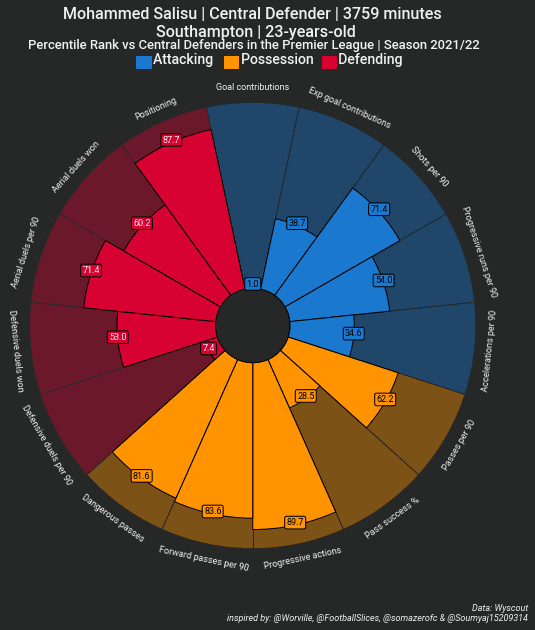
Once again, we can see from the pizza chart that Salisu had a very strong season last season, both in terms of his passing and ball progression and his work against the ball in the defensive phases of the game. He was less of a volume passer than even Merlin last season but his use of the ball was aggressive and proactive as a rule.
Indeed, Salisu ranked in the 62nd percentile for passes per 90 but in the 89th percentile for progressive actions and the 81st percentile for dangerous passes. His work in the defensive phase was very good and he ranked in the 87th percentile for positioning, a metric that accounts for interceptions and blocks.
While Southampton were content to turn down a big-money offer from Newcastle earlier in the season, it is difficult to envision then hanging on to the young defender in the medium to longer term.
The Central Midfielder
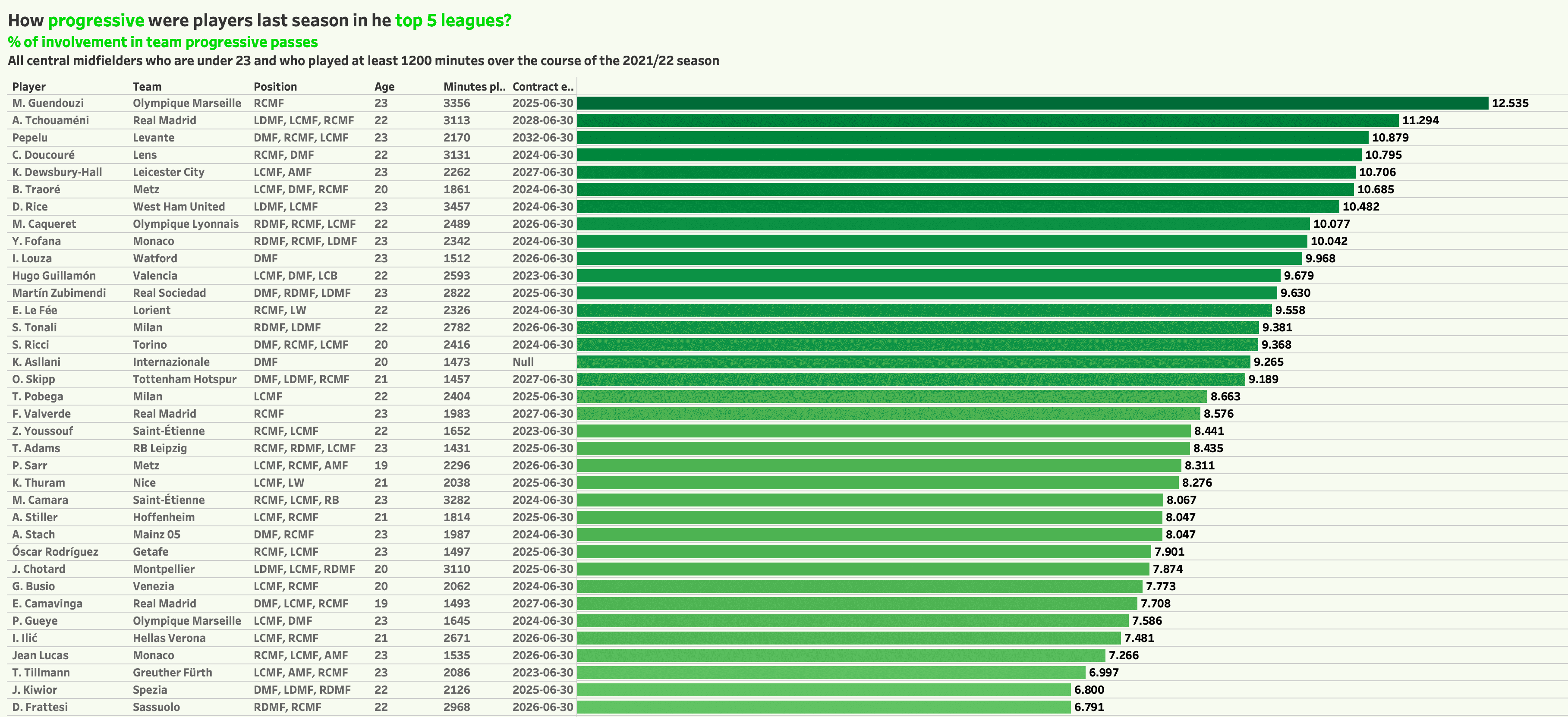
Finally, let’s move on to consider which central midfielders may be undervalued in terms of their ability to progress the ball through the thirds. Arsenal fans may be slightly surprised to see their former midfield enforcer Matteo Guendouzi at the top of the ranking but in truth, the midfielder has been reinvented since moving back to Ligue 1 with Marseille and we suspect that he is the profile of a midfielder that Arsenal coach Mikel Arteta would love to have at his disposal.
The second player on our list is, of course, anything but undervalued as Aurelien Tchouameni moved to Real Madrid from Monaco this summer for a fee reported to be in the region of £100M. Special mentions should also be made to the likes of Kiernan Dewsbury-Hall of Leicester City, who looks every inch a Premier League player, and Boubacar Traore of Metz but we will go with Cheick Doucoure, formerly of Lens this time around. As you can see Doucoure was responsible for 10.79% of all progressive passes made by Lens last season and the powerful and versatile midfielder has now been snapped up by Crystal Palace.
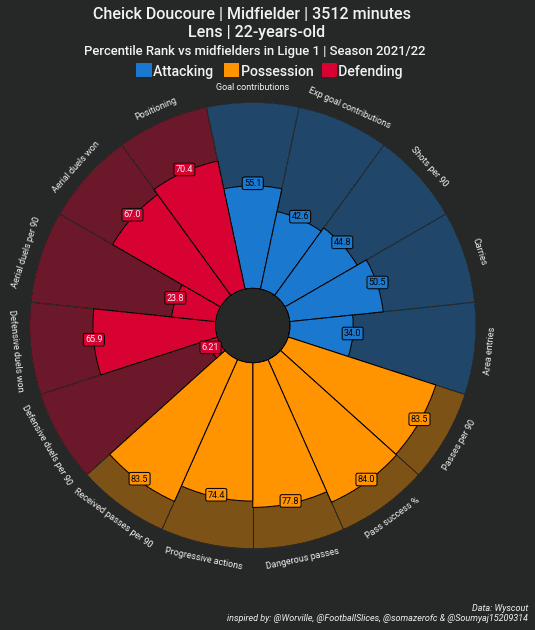
Cheick Doucoure is a midfield all-rounder who displays the ability to contribute decisively in all phases of the game. As you can see from his pizza chart he is active in the attacking and defensive phases of the game but it is with passing and ball progression that he really comes to life.
Doucoure ranks in the 83rd percentile for passes per 90, the 74th percentile for progressive actions and the 77th percentile for dangerous passes.
His performances for a Lens side who performed above expectations and finished in seventh place were consistently excellent last season and it is no surprise to see him getting a move to the Premier League.





Comments